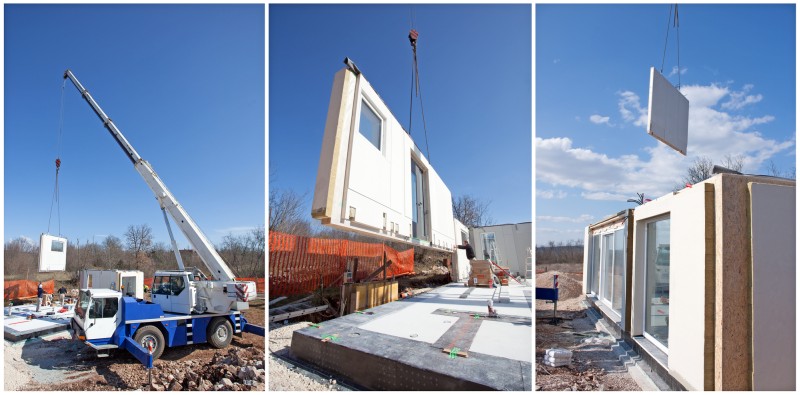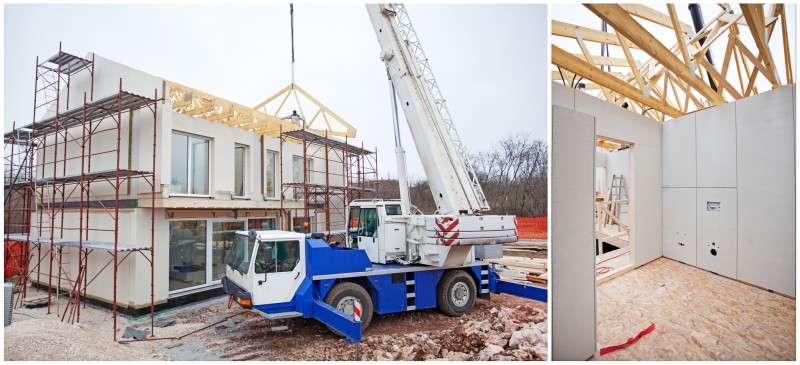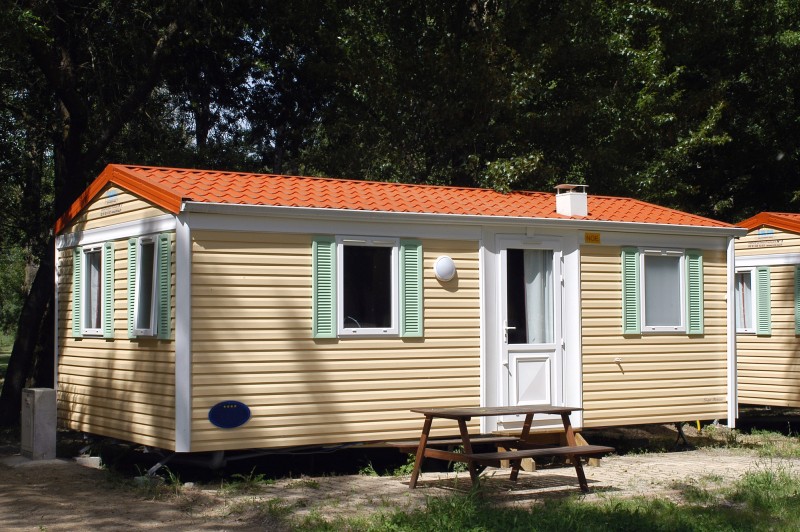In this article we will discuss modular homes, what they are, their advantages and disadvantages etc, so let’s get started.

Modular homes are abodes that are built in sections within factories before being transported to the homeowner’s plot by train or truck where skilled contractors assemble all prefabricated segments.
Construction stages take place inside a facility where walls, drywall, roof-framing, painting and quality-control checks take care of between 80- and 90-percent of the build before the unit is shipped to the home site.
Once delivered, contractors complete the work needed to assemble sections, attach utility lines and anchor the building to a foundation if the home is an off-frame type.
Not to be confused with motor homes, modular homes are often referred to as factory- or system-built houses, and they come in a surprising number of styles, sizes and layouts.
Two Types of Modular Homes
Type #1: Off-frame.
Off-frame models are considered the highest-quality modular homes. After manufacture and shipping, the shell is lifted off its transport frame and transferred to a permanent foundation, making off-frame homes more permanent.
More expensive than on-frame houses, off-frame models may appreciate in value at a rate that is comparable to site-built homes, making them better investments.
Type#2: On-frame.
When this cheaper type of modular home is transported to the site, no foundation is required because the house remains on its steel-frame chassis.
On-frame house types are more affordable because no slab is required on which to seat the structure. Relocating on-frame houses is easier, but some lenders consider these units the equivalent of mobile homes, so getting financing tends to be more difficult.
Some History of Modular Homes
While plenty of people believe that modular home building began in the 19th century, historians tell us the first ones actually arrived on U.S. shores in the 1600s when migrants moving to the U.S. from England had their homes disassembled and shipped in sections across the ocean by boat.
It took another 300 years before E.F. Dodgson established the first modular home manufacturing plant.
Companies like Sears and Roebuck and Montgomery Ward followed suit by manufacturing prefabs and selling them via catalogs and other forms of advertising.
By adopting methods pioneered by Henry Ford’s assembly lines, fabricating modular homes became a faster, more efficient process that has grown more sophisticated while satisfying homeowners who either can’t afford to custom build or have no desire to buy tract homes.
Today’s tiny house trend is an offspring of the modular home movement, another reason this industry has grown to include familiar marketing conduits like eBay and Amazon.

Pros of Modular Homes
- Modular homes take no time to install. Once components arrive from the manufacturer and a contractor arrives on scene, as long as weather is cooperative, a decent number of crew members can get that house built fast. Compared to the length of time it takes to build a traditional home on a vacant lot, modular home construction literally moves at warp speed by comparison.
- Today’s modular home is a high-quality residence. Manufacturing and materials have improved over time to such an extent, some prefabs could easily be mistaken for traditional builds. Assembly line construction is highly-mechanized and quality control measures offer additional assurances. Some modular home builders insist that the quality of their structures is equal to that of stick-built houses.
- Save money by choosing a modular home. Industry professionals estimate savings to be up 15-percent less than a comparable stick build onsite. Because all of the components that go into making modular home sections are uniform, there are fewer costs involved with the build. Further, there is less down time because crews don’t have to contend with weather, union strikes or factors that can increase the final cost of a home.
- It’s easier to get financing. As an outgrowth of the popularity of today’s modular home option, more manufacturers are offering to finance these buildings in addition to constructing them. For consumers with decent credit, loans for modular homes can be had as easily as those for site-built home applicants. Due to the healthy evolution of this industry, you can even find comparable insurance rates for modular homes.
- Quality modular homes not only appraise the same as on-site builds but many appreciate in value. Customization has become so commonplace, these structures can be shipped directly to lots where crawl spaces and basements already exist. Considered permanent “real property” structures, modular homes may also qualify for tax breaks since they are considered a form of green building, and customization has become commonplace rather than the exception.
- Modular homes are safe. If built according to industry standards, modular homes can sustain winds of up to 175-miles per hour, say FEMA authorities, so consumers eager to build in areas prone to tropical weather patterns are offered reassurances by manufacturers taking into account climate differences. Because they must meet stringent building code standards, modular homes use between 15- and 20-percent more wood than site-built structures which makes them stronger and safer according to folks who test and inspect these structures before they are delivered.
Cons of Modular Homes
- You must confront public perception. Despite innovation and improvements associated with modular home building, simply mentioning the fact that a home is prefabricated can turn off home shoppers. There is a stigma associated with modular homes that continues to impact home sales. Keep that in mind if your intention is to live in the home for a short period of time before selling and moving on.
- You can’t have it all. While stick-built homes allow a consumer to maximize their customization ideas, there are limits when it comes to modular homes. Even sophisticated plans offered by manufacturers must stick fairly closely to a series of templates offered by the company, so if your idea of idyllic living calls for a loft, circular floor plan or unusual structural features, you may have to make some compromises.
- Financing could be problematic. While some manufacturers offer financing, you may have to undergo a more rigorous loan acquisition process when dealing with mortgage companies and banks. Some lenders mandate a loan that covers the builder and a second loan to finance the remaining debt with interest. Interest rates, closing costs and time limits can differ from those associated with stick-built home financing. Good places to start are USDA construction loans, FHA loans and VA loans plus local banks.
- Don’t forget the land. The price of the parcel of real estate you purchase in order to build your home can double the final cost of your homestead and not every property is zoned for modular homes – even those zoned for mobile homes. Additionally, if you choose a beautiful site that meets your needs and wants, it may not be hooked up to sewer systems and utilities which could add major costs to your project that may include the installation of a septic system.
- Some neighborhoods don’t permit modular homes. Land restrictions, topography, municipal government rules and regulations could all interfere with your plan to build your modular home on the lot you like. Inquire into restrictive covenants that apply to the parcel of land you have set your sights on buying before you make the purchase. Sadly, these prohibitions are often put into place by communities that do not understand the great strides modular home design and manufacturing have made over time.
- You could have trouble selling. Having said multiple times within the body of this article that today’s modular homes are as beautiful and sophisticated as traditional stick houses, that doesn’t mean that all home shoppers will welcome the revelation that the house that looks like a stick-built is actually modular. That stated, you can short-circuit adverse reactions by hiring an experienced realtor who knows the modular home market and is skilled in the art of pre-qualifying home shoppers.
What’s the difference between a modular home and a mobile home?
For starters, the fact that a modular home is installed on a piece of property within a community of stick-built homes elevates a prefab above a mobile home that can be disconnected from utility tethers, hitched up and driven away.

Mobile homes (as the one shown above), while also built to higher standards, lack the prestige, resale advantages and permanent foundation on which a modular home is placed.
Because modular houses are built of the same materials as those used to construct stick houses, modular houses are safer than mobile homes because they are better grounded, more stable and better anchored to foundations.
Further, neighborhoods into which both styles of homes are allowed to be placed can be dramatically distinct. While modular homes offer a sense of permanence, that can’t be said about mobile homes that — even in the best mobile home parks — are unlikely to retain as much value as modular homes.
Modular vs Stick-built Houses
-It takes much longer to construct a stick-built house; months rather than weeks.
-Modular homes may be burdened with additional rules, guidelines and building codes not applicable to stick-built homes.
-You will almost always spend less money on a modular home than you would on a house built from the ground up.
-Modular home sections are built in climate-controlled facilities while stick-built houses are subject to weather conditions that impact building materials during a long build-out.
-All inspections undertaken during the building phase of modular homes are performed at the factory while inspections are drawn out when completing a stick-build home.
-Modular homes tend to be more energy efficient than stick-build homes thus utility bills are likely to be lower.
Average costs associated with building a modular home in the U.S.
On average, say estimators at Home Guide, the base cost to build a 1,500 square-foot modular house will range between $75,000 and $150,000.
Add between $28,000 and $160,000 for on-site prep, installation and finishing work. This averages between $30 and $60 per square foot. The following list provides you with more detailed breakout estimates:
-Land prep; survey; clearing; excavation; grading ($4,000 to $11,000).
-Foundation for off-frame models; basement; crawl space, pier and beam; stilts/pilings ($6,000 to $20,000).
-Delivery at $5 to $10 per square foot depending upon distance, modules and house size ($3,000 to $12,000).
-Taxes ($5,000 to $15,000).
-Installation; connecting modules; interior finishing; drywall, carpentry and trim; doors and window install; interfacing appliances; exterior siding, roof, gutters ($10,000 to $50,000).
-Utility installs: electrical panels; wiring; septic system; sewer line; water main; wet drilling; plumbing system; gas line install, HVAC costs ($2,500 to $25,000).
-Permits and fees; includes testing and inspection to validate building code requirements and mandates; building and mechanical permits; pre-plan review; certificate of occupancy ($500 to $4,000).
Resources
https://www.mymove.com/home-inspiration/decoration-design-ideas/basic-facts-about-modular-homes/
https://www.maxrealestateexposure.com/pros-and-cons-of-modular-homes/
https://www.modular.org/HtmlPage.aspx?name=MA-oi-History-of-Modular
https://www.triadfs.com/news/how-manufactured-homes-differ-from-mobile-and-modular-homes
https://homeguide.com/costs/modular-home-prices
Related Posts
- Comparison of Shiplap vs “Tongue and Groove” vs Beadboard Wall Paneling
- Comparison of Manufactured vs Modular Homes with Pros/Cons
- 10 Different Types of Glass for Home Windows (With Pros and Cons)
- Here Are The Main Pros and Cons of a Barndominium House
- Main Advantages and Disadvantages of Vaulted Ceilings for Homes
- Top 9 Drywall Alternatives for Your Home Ceiling (With Photos)
Leave a Reply